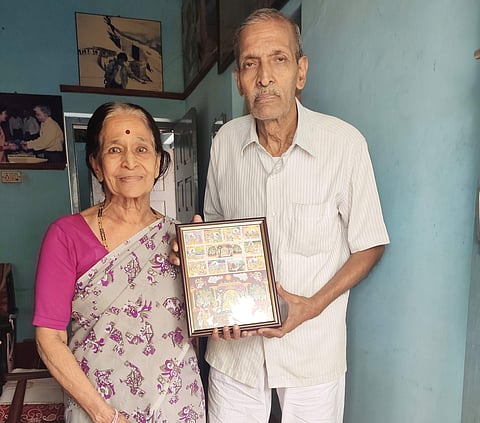

A few days ago, Professor R G Sangoram donated hundreds of stamps to the Indian Institute of Science (IISc). They, in turn, happily collected these stamps and even put them on display in an exhibition in their Archives department. But a whole exhibition for one man's stamp collection? Sounds a bit extreme we thought, so we decided to catch up with the retired professor and we were nothing short of amazed. Collecting stamps isn't just some childhood hobby for Sangoram — stamps are more like a treasure to him as they convey a lot of information about a country, place, culture or person. These stamps exhibited at IISc are of greater importance because a set of them tell us the history of the Moon landing and how different countries sent their astronauts to the Moon. There is also a collection of stamps on Astrophysics and the various scientists who contributed to it.
And not just stamps, there are hundreds of postcards, envelopes, miniature sheets and much more in this intriguing collection. Explaining the story behind his interest, Sangoram says, "The philately collection was started by my daughter Keerthi Sangoram. She developed the habit of collecting stamps in class VIII. Her dedication and commitment motivated me to also be part of her hobby. It was this hobby that took her to various countries and Keerthi even represented India in philately exhibitions. In 1999, she died due to an adverse reaction to antibiotics. I eventually had to move on but I wanted to keep this hobby alive. Till date, I have collected stamps on thirteen different topics including Solar System, Man on the Moon, Communication, Rocks and Minerals, Winston Churchill, Nobel Laureates, Heroes of Medicine, Flowers, Philatelics Terms, to name a few. All of these together cost more than `15 lakh."
There are two types of stamp collections — while one is a thematic stamp collection, the other one is a classic collection. Thematic stamps can be anything related to animals, birds, planets etc. But a classic collection is all about the history of a particular region, for example, collecting stamps released to highlight the rule of the Mysore kings or queens. Sangoram believes that every stamp is a little ambassador of every nation. "A philatelist should not bother about the countries that the stamps belong to. They must only look for some rare stamps that have an error. Sometimes, the countries would have printed the wrong person's name. For example, in one of the Apollo 13 space mission stamps, an astronaut's name was wrongly printed. Such stamps are very unique. The postal department first prints these stamps in a book and every year, when they release new ones, they add them to the book," he explains.
The Man on the Moon theme has many extraordinary stamps and postcards. One of the postcards has a picture of cosmonauts Rakesh Sharma, Gennadi Strekalov and Yury Malyshev. 'Space Exploration for Peace' are the words that are printed on the card. When asked about the reason behind these words, he explains, "In the 1980s, many superpower nations came together and printed stamps like 'Atom for Peace' and 'Space Exploration for Peace' to show that explorations and experiments were not to wage war against each other but for the good progress of the human race. Did you know that the USSR sent dogs to space — Laika, Belka and Sterlka? They released stamps on them too. I want school children to learn all these fun (and serious) facts through my stamps."
This is not the first time that Sangoram has donated stamps to IISc. Earlier, he donated over hundreds of stamps to the Stone Museum set up by the Mines and Geology department. These stamps include pictures of gold mines and unique stones found in India. Similarly, his collection of communication stamps depicts the communication medium from the Stone Age to the Modern Age. Even his flower-themed collection has 2,000 varieties of flowers. He says, "Among my numerous collections, my unique collection is the one of philatelic terms which people rarely have in their collection. These terms are nothing but the devices used in postal departments printed on stamps or postcards."
Until a few years ago, Sangoram and his wife Rajamani C E were invited by the postal department to conduct workshops in different districts of Karnataka. Now, as age has caught up with them, they are unable to travel long distances. "Even now, many people come to my house to learn the nuances of stamp collection. There are procedures that philatelists follow. Primarily, one needs to have patience and dig deeper in terms of research or contact foreign dealers. They are the best to help you get foreign stamps. This way, one can make good friends across the globe to exchange stamps," he concludes.
